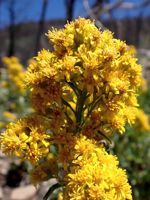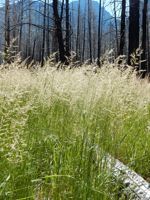Mon-Fri 9am - 5pm Mountain time
Missouri Goldenrod vs Bluejoint
Solidago missouriensis
Calamagrostis canadensis
NOT AVAILABLE THIS SEASON - MIGHT RETURN
CUSTOM GROW
Missouri Goldenrod is a native perennial wildflower known for its brilliant golden yellow flowers that bloom from late summer to early fall. The flower heads contain hundreds of tiny blossoms that attract a wide variety of pollinators, including bees, butterflies, and other beneficial insects. Fully opened flowers can also be used to make tea. As the season progresses, the flowers give way to fluffy seed heads, providing food for birds.
It can spread readily through its roots and self-seeding, this make Missouri Goldenrod well suited for hard-to-grow areas. This vigorous growth habit makes it an excellent choice for large planting areas, wildflower gardens, naturalized projects, prairie restoration, and erosion control.
Bluejoint is a native perennial grass that forms tall, dense colonies. It is one of the most abundant grasses found in Canada and the United States. The extensive shallow root system and spreading rhizomes help stabilise soils, especially in wet meadows, marshes, and along streambanks.
It is a cool-season grass, growing most actively in spring and fall and slowing during the heat of summer. Seeds from its purple-tinged spikes feed birds and small mammals, and the plant itself provides forage for wildlife and livestock, though it does not tolerate heavy grazing. Its tall, dense growth also offers nesting habitat for wetland birds. With these combined values, Bluejoint is well-suited for naturalisation, riparian plantings, and habitat restoration projects.

